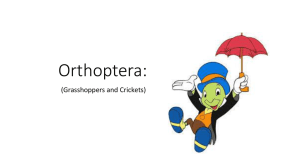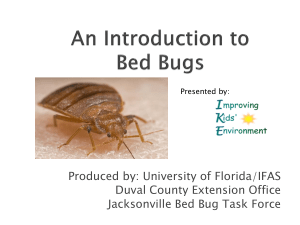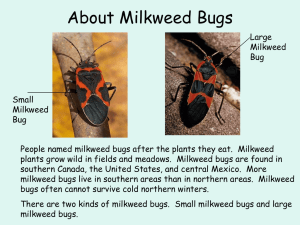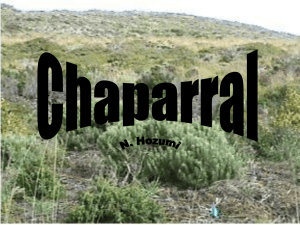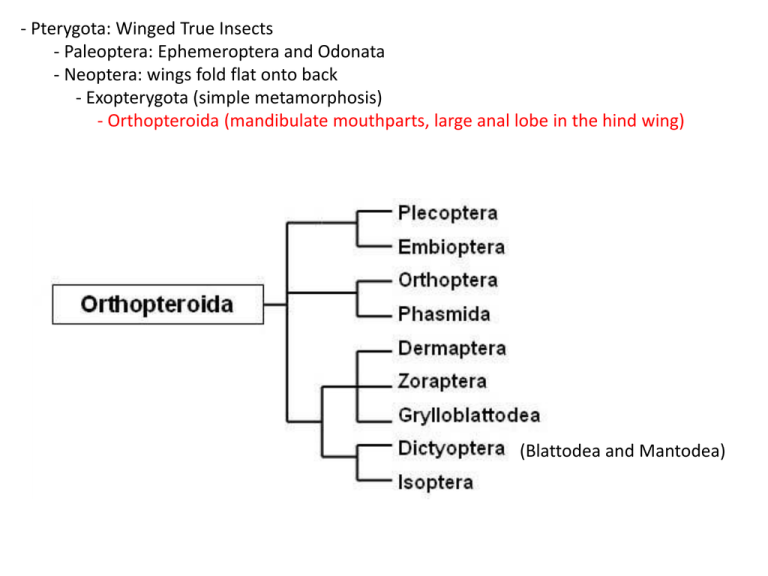
- Pterygota: Winged True Insects
- Paleoptera: Ephemeroptera and Odonata
- Neoptera: wings fold flat onto back
- Exopterygota (simple metamorphosis)
- Orthopteroida (mandibulate mouthparts, large anal lobe in the hind wing)
(Blattodea and Mantodea)
- Pterygota: Winged True Insects
- Paleoptera: Ephemeroptera and Odonata
- Neoptera: wings fold flat onto back
- Exopterygota (simple metamorphosis)
- Orthopteroida (mandibulate mouthparts, large anal lobe in the hind wing)
ORDER: Plecoptera – Stoneflies
- aquatic larvae with thoracic gills and two caudal filaments (cerci)
- Pterygota: Winged True Insects
- Paleoptera: Ephemeroptera and Odonata
- Neoptera: wings fold flat onto back
- Exopterygota (simple metamorphosis)
- Orthopteroida (mandibulate mouthparts, large anal lobe in the hind wing)
ORDER: Plecoptera – Stoneflies
- aquatic larvae with thoracic gills and two caudal filaments (cerci)
- nymphs feed on plants and algae; some are predaceous and / or omnivorous
ORDER: Plecoptera – Stoneflies
- aquatic larvae with thoracic gills and two caudal filaments (cerci)
- nymphs feed on plants and algae; some are predaceous and / or omnivorous
- many adults don’t feed; they are soft-bodied and poor fliers. Wings are folded back over
abdomen, and hind wing has a large anal lobe. Found near water.
ORDER: Plecoptera – Stoneflies
Two groups (by classification, not phylogenetically) distinguished by the relative sizes of
glossae and paraglossae
Both like this
ORDER: Plecoptera – Stoneflies
Glossae and paraglossae about the same size:
1. Pteronarcyidae – Giant Stoneflies (10 sp.)
- very large, may reach 55 mm in length!
- larvae with gill remnants on the first two abdominal segs.
- 3 ocelli; basal segment of tarsi shorter than 3rd (distal) segment
ORDER: Plecoptera – Stoneflies
Glossae and paraglossae about the same size:
1. Pteronarcyidae – Giant Stoneflies
2. Peltoperlidae – Roach-like Stoneflies (17)
- glossae same size but no abdominal gills, 2 ocelli, basal tarsus shorter than 3rd
ORDER: Plecoptera – Stoneflies
Glossae and paraglossae about the same size:
1. Pteronarcyidae – Giant Stoneflies
2. Peltoperlidae – Roach-like Stoneflies
3. Taeniopterygidae – Winter stoneflies (33)
- glossae same size, tarsal segments are equal in length; in some the wingpads are highly
divergent (though like this in other families, too).
ORDER: Plecoptera – Stoneflies
Glossae and paraglossae about the same size:
1.
2.
3.
4.
Pteronarcyidae – Giant Stoneflies
Peltoperlidae – Roach-like Stoneflies
Taeniopterygidae – Winter stoneflies
Nemouridae – Spring Stoneflies (64)
- glossae equal, tarsal length goes 2nd (shortest), third, basal (longest)
- cerci short, wings flat at rest
- larvae may have cervical gills
ORDER: Plecoptera – Stoneflies
Glossae and paraglossae about the same size:
1.
2.
3.
4.
5.
Pteronarcyidae – Giant Stoneflies
Peltoperlidae – Roach-like Stoneflies
Taeniopterygidae – Winter stoneflies
Nemouridae – Spring Stoneflies
Leuctridae – Rolled-wing Stoneflies (52)
- short cerci in adult; wings roll around abdomen
- glossae equal, tarsal length goes 2nd (shortest), third, basal (longest)
ORDER: Plecoptera – Stoneflies
Glossae and paraglossae about the same size:
1.
2.
3.
4.
5.
6.
Pteronarcyidae – Giant Stoneflies
Peltoperlidae – Roach-like Stoneflies
Taeniopterygidae – Winter stoneflies
Nemouridae – Spring Stoneflies
Leuctridae – Rolled-wing Stoneflies
Capniidae – Small winter stoneflies (131)
- glossae equal, tarsal length goes 2nd (shortest), third, basal (longest)
- adults with long cerci
ORDER: Plecoptera – Stoneflies
Glossae and paraglossae small and different in size:
ORDER: Plecoptera – Stoneflies
Glossae and paraglossae small and different in size:
1. Perlidae – Common Stoneflies (44)
- Larvae with highly branched gills on side and venter of thorax
ORDER: Plecoptera – Stoneflies
Glossae and paraglossae small and different in size:
1. Perlidae – Common Stoneflies (44)
- Larvae with highly branched gills on side and venter of thorax
- Larvae highly patterned; adults with remnants of branched gills
ORDER: Plecoptera – Stoneflies
Glossae and paraglossae small and different in size:
1. Perlidae – Common Stoneflies
2. Perlodidae – Perlodid Stoneflies (114)
- adult with pronotum rectangular or slightly rounded
ORDER: Plecoptera – Stoneflies
Glossae and paraglossae small and different in size:
1. Perlidae – Common Stoneflies
2. Perlodidae – Perlodid Stoneflies (114)
- adult with pronotum rectangular or slightly rounded
- no gills on thorax, patterned thorax, longer cerci than Chloroperlidae
ORDER: Plecoptera – Stoneflies
Glossae and paraglossae small and different in size:
1. Perlidae – Common Stoneflies
2. Perlodidae – Perlodid Stoneflies
3. Chloroperlidae – Green Stoneflies (72)
- Adults are usually yellow or green!! YAY!!
ORDER: Plecoptera – Stoneflies
Glossae and paraglossae small and different in size:
1. Perlidae – Common Stoneflies
2. Perlodidae – Perlodid Stoneflies
3. Chloroperlidae – Green Stoneflies (72)
- Adults are usually yellow or green!! YAY!!
- no gills on thorax, thorax that is not patterned, shorter cerci than Perlodidae
ORDER: Plecoptera – Stoneflies
Phylogeny of Stoneflies
- Pterygota: Winged True Insects
- Paleoptera: Ephemeroptera and Odonata
- Neoptera: wings fold flat onto back
- Exopterygota (simple metamorphosis)
- Orthopteroida (mandibulate mouthparts, large anal lobe in the hind wing)
(Blattodea and Mantodea)
ORDER: Orthoptera – Grasshoppers, Katydids, and Crickets
- most adults and nymphs feed on plant material, although some are predatory and some
are scavengers.
- most are winged – with four wings in which the front wings are leathery ‘tegmina’
(singular is ‘tegmen’). The wings fold fan-like over the back.
There are several families with
exclusively western distributions…
we’ll forget about those!!
ORDER: Orthoptera – Grasshoppers, Katydids, and Crickets
- Suborder Caelifera – “short-horned” grasshoppers (short antennae)
1. Romaleidae – Lubber Grasshoppers (1 in east) – Romalea microptera (Beauvois)
Huge (to 75mm) with
reduced wings; hind wing
red with black border.
ORDER: Orthoptera – Grasshoppers, Katydids, and Crickets
- Suborder Caelifera – “short-horned” grasshoppers (short antennae)
1. Romaleidae – Lubber Grasshoppers
2. Acrididae – Grasshoppers (>300 sp)
- like other families in the suborder, antennae are short, tarsi are 3-segmented, auditory
organ on first abdominal segment
ORDER: Orthoptera – Grasshoppers, Katydids, and Crickets
1. Romaleidae – Lubber Grasshoppers
2. Acrididae – Grasshoppers
- like other families in the suborder, antennae are short, tarsi are 3-segmented, auditory
organ on first abdominal segment
- pronotum short – only covers thorax
ORDER: Orthoptera – Grasshoppers, Katydids, and Crickets
1. Romaleidae – Lubber Grasshoppers
2. Acrididae – Grasshoppers
- like other families in the suborder, antennae are short, tarsi are 3-segmented, auditory
organ on first abdominal segment
- “call” two ways – some ‘stridulate’ by rubbing file on hind femur against the wing….
sound
Sounds and picture from: http://biology.nicerweb.com/Locked/media/ch01/Insects.html
ORDER: Orthoptera – Grasshoppers, Katydids, and Crickets
1. Romaleidae – Lubber Grasshoppers
2. Acrididae – Grasshoppers
- like other families in the suborder, antennae are short, tarsi are 3-segmented, auditory
organ on first abdominal segment
- “call” two ways – some ‘stridulate’ by rubbing file on hind femur against the wing….
In North America, these are limited to the subfamily Gomphocerinae – the stridulating
grasshoppers … they have a slanted face (but short antennae)
ORDER: Orthoptera – Grasshoppers, Katydids, and Crickets
1. Romaleidae – Lubber Grasshoppers
2. Acrididae – Grasshoppers
- like other families in the suborder, antennae are short, tarsi are 3-segmented, auditory
organ on first abdominal segment
- “call” two ways – others in one subfamily (Oedinpodinae – “Banded-winged
grasshoppers”) clap wings in flight….
sound
Sounds and picture from: http://biology.nicerweb.com/Locked/media/ch01/Insects.html
ORDER: Orthoptera – Grasshoppers, Katydids, and Crickets
1. Romaleidae – Lubber Grasshoppers
2. Acrididae – Grasshoppers
- like other families in the suborder, antennae are short, tarsi are 3-segmented, auditory
organ on first abdominal segment
- “call” two ways – some ‘stridulate’ by rubbing file on hind femur against the wing;
others ‘call’ by clapping their wings in flight
- extremely important as agricultural pets. From the locusts to the more speciose ‘spurthroated grasshoppers’, they can reach plague populations and devastate crop
production.
video
ORDER: Orthoptera – Grasshoppers, Katydids, and Crickets
1. Romaleidae – Lubber Grasshoppers
2. Acrididae – Grasshoppers
3. Tetrigidae – Pygmy Grasshoppers (27)
- easy to distinguish because their pronotum is long and covers the abdomen
From: John R. Meyer, North Carolina State University. http://www.cals.ncsu.edu/course/ent425/spotID/Orthoptera/tetrigid.html
ORDER: Orthoptera – Grasshoppers, Katydids, and Crickets
- Suborder Ensifera: the ‘long-horned’ grasshoppers, with antennae that are long and
filametous, often langer than the body. The auditory organs are on the inside of the
front tibia. Many with a long ovipositor.
ORDER: Orthoptera – Grasshoppers, Katydids, and Crickets
1. Tettigoniidae – Katydids (265)
- long filamentous antennae, long ovipositors, tympani on front tibae, 4-seg tarsi.
- most species stridulate by rubbing file on one wing against the other.
Songs at: http://entnemdept.ufl.edu/walker/buzz/141a.htm
ORDER: Orthoptera – Grasshoppers, Katydids, and Crickets
1. Tettigoniidae – Katydids (265)
- long filamentous antennae, long ovipositors, tympani on front tibae, 4-seg tarsi.
- most species stridulate by rubbing file on one wing against the other.
Shield-backed katydid
Cone-headed katydid
ORDER: Orthoptera – Grasshoppers, Katydids, and Crickets
1. Tettigoniidae – Katydids
2. Rhaphidophoridae – Cave or Camel Crickets (89)
- brown, humpbacked, and living in dark places like caves, hollow trees, and crawlspaces.
New Zealand “Giant Weta’s” – 11 species of giant ‘crickets’ (genus Deinacrida) –
A good example of island gigantism – 4 inch bodies, up to 70 grams (heaviest insect
recorded)
ORDER: Orthoptera – Grasshoppers, Katydids, and Crickets
1. Tettigoniidae – Katydids
2. Rhaphidophoridae – Cave or Camel Crickets
3. Gryllidae – Crickets (~200)
- similar to tettigoniids, but tarsi are 3 segmented or less. Ovipositor is not flattened
laterally, but is needle-like or cylindrical. They have tympani on foretibia, and males
stridulate with scraper and file like katydids. They are omnivorous.
Tree crickets
ORDER: Orthoptera – Grasshoppers, Katydids, and Crickets
1. Tettigoniidae – Katydids
2. Rhaphidophoridae – Cave or Camel Crickets
3. Gryllidae – Crickets (~200)
- similar to tettigoniids, but tarsi are 3 segmented or less. Ovipositor is not flattened
laterally, but is needle-like or cylindrical. They have tympani on foretibia, and males
stridulate with scraper and file like katydids. They are omnivorous.
Ground cricket
House cricket
Bush cricket
ORDER: Orthoptera – Grasshoppers, Katydids, and Crickets
1.
2.
3.
4.
Tettigoniidae – Katydids
Rhaphidophoridae – Cave or Camel Crickets
Gryllidae – Crickets
Gryllotalpidae - Mole Crickets (7)
Rare but too cool to leave out… they burrow like moles, and have huge forelimbs modified
for digging. The males stridulate. Can damage crops.
- Pterygota: Winged True Insects
- Paleoptera: Ephemeroptera and Odonata
- Neoptera: wings fold flat onto back
- Exopterygota (simple metamorphosis)
- Orthopteroida (mandibulate mouthparts, large anal lobe in the hind wing)
(Blattodea and Mantodea)
ORDER: Phasmida – Walkingsticks
- sister group to the Orthoptera, they lack jumping legs, have 5-segmented tarsi (most),
and elongate bodies with reduced or absent wings. Some species are apparently
parthenogenetic, as no males have been found. One family is limited to the west and one
to Florida.
1. Heteronemiidae – Common Walkingsticks (20)
- uh, it’s a walking stick! (mesothorax 4x length of prothorax)
- longest insect in U. S. : Megaphasma denticrus (Stal) – to 180mm
ORDER: Phasmida – Walkingsticks
1. Heteronemiidae – Common Walkingsticks
2. Pseudophasmatidae – Striped Walkingsticks (2)
- first abdominal seg as long as metanotum
- there are several introduced species. Members of the
genus Anisomorpha can spray a whitish chemical from a
pronotal gland up to 40cm with great accuracy, aiming
for the eyes.
“Although Gray (1835) mentioned the defensive secretion of A.
buprestoides, the first account of its effect on humans that could be
located was by Stewart (1937), who wrote about an incident in Texas:
"The victim was observing a pair of Anisomorpha buprestoides . . . with
his face within two feet of the insects, when he received the discharge
in his left eye. . . The pain in his left eye was immediately excruciating;
being reported to be as severe as if it had been caused by molten lead.
Quick, thorough drenching with cool water allayed the burning agony to
a dull aching pain. The pain eased considerably within the course of a
few hours. Upon awakening the next morning the entire cornea was
almost a brilliant scarlet in color and the eye was so sensitive to light
and pressure for the next forty-eight hours that the patient was
incapacitated for work. Vision was impaired for about five days."
Symptoms gradually disappeared and there were no lasting effects.
Albert (1947) described a similar but less severe incident.”
From: Thomas (2003).
http://entnemdept.ufl.edu/creatures/misc/walkingstick.htm
ORDER: Phasmida – Walkingsticks
1. Heteronemiidae – Common Walkingsticks
2. Pseudophasmatidae – Striped Walkingsticks (2)
-Mesonotum at most 3x pronotum in length
- first abdominal seg as long as metanotum
the eyes.
- Pterygota: Winged True Insects
- Paleoptera: Ephemeroptera and Odonata
- Neoptera: wings fold flat onto back
- Exopterygota (simple metamorphosis)
- Orthopteroida (mandibulate mouthparts, large anal lobe in the hind wing)
(Blattodea and Mantodea)
ORDER: Dermaptera – Earwigs (22 species; 10 native)
- The order is distinguished by a pincer-like set of cerci called the forceps. They are winged
or wingless insects; if winged, then the forewings are short and leathery and hide hind
wings. Tarsi with three segments.
- Most are detritivores, some are herbivorous or predaceous
- some produce a foul-smelling fluid as a defensive secretion
- they can use their forceps to pinch
ORDER: Dermaptera – Earwigs (22 species; 10 native)
1. Forficulidae – European and Spinetailed Earwigs
- second tarsal segment extends beyond the first (basal) segment, and it is expanded
- antennae with 12-16 segments, yellow/brown
European earwig (male)
Spinetail (Genus Doru)
ORDER: Dermaptera – Earwigs (22 species; 10 native)
1. Forficulidae – European and Spinetailed Earwigs
2. Labiduridae – Striped Earwigs (8)
- Second tarsal segment normal
- Antennae with 25-30 segments
- pronotum often with stripes
ORDER: Dermaptera – Earwigs (22 species; 10 native)
1. Forficulidae – European and Spinetailed Earwigs
2. Labiduridae – Striped Earwigs
3. Anisolabididae – Seaside and Ring-legged Earwigs
- second tarsal segment normal
- male right forceps curves more than left
- antennae 14-24 segments
ORDER: Dermaptera – Earwigs (22 species; 10 native)
1. Forficulidae – European and Spinetailed Earwigs
2. Labiduridae – Striped Earwigs
3. Anisolabididae – Seaside and Ring-legged Earwigs
4. Labiidae – Little Earwigs
- antennae 10-16 segments
Labia minor - 7mm, gold hairs
- Pterygota: Winged True Insects
- Paleoptera: Ephemeroptera and Odonata
- Neoptera: wings fold flat onto back
- Exopterygota (simple metamorphosis)
- Orthopteroida (mandibulate mouthparts, large anal lobe in the hind wing)
(Blattodea and Mantodea)
ORDER: Mantodea – Mantids (17 species, 4 introduced)
Unmistakeable; two families, but one is limited to Florida
1. Mantidae – Mantids (12)
Our state insect: Stagomantis carolina
Gonatista grisea
Lichen mimic native to
southeastern U.S.
Ootheca – egg case
Chinese mantis – Tenodera aridifolia
ORDER: Blattodea – Roaches (~50)
- head is concealed from above by an enlarged pronotum
- legs unmodified for jumping, grasping
- usually no stridulating organs
- tarsi 5-segmented
- wings generally present, but may be reduced
- eggs also in oothecae
- omnivorous
ORDER: Blattodea – Roaches (~50)
1. Blattidae
- ventroposterior margin of front femora with spines of equal length, or decreasing in
length distally
- female subgenital plate divided lengthwise; male styli similar
- generally large (25mm)
- includes the Oriental cockroach (Blatta orientalis L.) and American cockroach
(Periplaneta americana (L.)) . The American is large (2 in.) – “Palmetto Bugs” – (from
Africa)
ORDER: Blattodea – Roaches (~50)
Wood roach
Parcoblatta spp.
1. Blattidae
2. Blatellidae
- spines on front femora quite variable
- smaller
- subgenital plate of female entire (not divided)
German cockroach
Blattella germanica (L.)
Brown-banded cockroach
Supella longipalpa (Fabricius)
ORDER: Blattodea – Roaches (~50)
1. Blattidae
2. Blatellidae
3. Blaberidae
- includes the largest roaches in U. S.
- spines on front femora just at tip, or also three on ventromedial margin
- no oothecae; they retain it in uterus and give live birth
Madiera cockroach
Rhyparobia maderae
- Pterygota: Winged True Insects
- Paleoptera: Ephemeroptera and Odonata
- Neoptera: wings fold flat onto back
- Exopterygota (simple metamorphosis)
- Orthopteroida (mandibulate mouthparts, large anal lobe in the hind wing)
(Blattodea and Mantodea)
ORDER: Isoptera – Termites (44)
- Hormones and inhibitory phernomes secreted by the reproductives and soldiers
determine caste in male and female nymphs; they can develop into any caste.
- Wings are similar in size (iso-ptera) in the reproductives (the caste with wings)
- soft-bodied except for the king and queen.
Reproductives leave a colony in a mating swarm – pairing to establish new colonies. After
the ‘nuptual flight’, the reproductives lose their wings.
video
ORDER: Isoptera – Termites (44)
- Hormones and inhibitory phernomes secreted by the reproductives and soldiers
determine caste in male and female nymphs; they can develop into any caste.
- Wings are similar in size (iso-ptera) in the reproductives (the caste with wings)
- soft-bodied except for the king and queen.
Reproductives leave a colony in a mating swarm – pairing to establish new colonies. After
the ‘nuptual flight’, the reproductives lose their wings.
Queens grow into an egg machine and live for 20 years
video
ORDER: Isoptera – Termites (44)
Soldiers and nasutes (in some colonies) product the colony. Soldiers have huge jaws and
nasutes have a ‘squirt-head’. In Cryptotermes, the soldiers have a block-head that blocks
the termite burrow.
ORDER: Isoptera – Termites (44)
1. Kalotermitidae - Drywood, Dampwood, and Powderpost termites (17)
- they do not construct earthen tubes, tending to only create cavities in the wood.
Reproductives have ocelli; soldiers have blunt, concave heads
ORDER: Isoptera – Termites (44)
1. Kalotermitidae - Drywood, Dampwood, and Powderpost termites
2. Rhinotermitidae – Subterranean termites (9)
- build earthen tubes and maintain contact with the ground
- a fontanelle on the head
- small
Reticulitermes flavipes – nest
in soil, then colonize wood in a
home.
- Pterygota: Winged True Insects
- Paleoptera: Ephemeroptera and Odonata
- Neoptera: wings fold flat onto back
- Exopterygota (simple metamorphosis)
- Orthopteroida (mandibulate mouthparts, large anal lobe in the hind wing)
- Hemipteroida (sucking mouthparts, typically)
Phthiraptera
ORDER: Hemiptera – True Bugs, hoppers, aphids
Sucking mouthparts, used to suck plant juices or
blood, or to stab prey
ORDER: Hemiptera – True Bugs, Hoppers, Aphids
Sucking mouthparts, used to suck plant juices or
blood, or to stab prey
ORDER: Hemiptera – True Bugs, Hoppers, Aphids
Sucking mouthparts, used to suck plant juices or
blood, or to stab prey
ORDER: Hemiptera – True Bugs, Hoppers, Aphids
Sucking mouthparts, used to suck plant juices or blood, or to
stab prey
ORDER: Hemiptera – True Bugs, Hoppers, Aphids
Sucking mouthparts, used to suck plant juices or blood, or to
stab prey
“moss bugs” – 1 family (Peloridiidae) – southern
hemisphere – beak at front but hard part of forewing
reduced
ORDER: Hemiptera – True Bugs, Hoppers, Aphids
- Suborder: Heteroptera
ORDER: Hemiptera – True Bugs, Hoppers, Aphids
- Suborder: Heteroptera
The Aquatic Families (antennae shorter than head)
- ocelli present
1. Gelastocoridae – Toad Bugs (7)
- small family;, eyes protuberant, along margins of ponds – look
nymphal but winged adults. 10mm
ORDER: Hemiptera – True Bugs, Hoppers, Aphids
- Suborder: Heteroptera
The Aquatic Families (antennae shorter than head)
- ocelli present
1. Gelastocoridae – Toad Bugs
- ocelli absent
2. Corixidae – Water Boatmen (120)
- front tarsi 1-segmented and expanded into a scoop/”oar”
Dorsal surface with transverse lines, mostly algivores
ORDER: Hemiptera – True Bugs, Hoppers, Aphids
- Suborder: Heteroptera
The Aquatic Families (antennae shorter than head)
- ocelli present
1. Gelastocoridae – Toad Bugs
- ocelli absent
2. Corixidae – Water Boatmen (120)
3. Nepidae - Water Scorpions (12)
- small group but easy to identify: 2 long filaments and raptorial
forelegs
ORDER: Hemiptera – True Bugs, Hoppers, Aphids
- Suborder: Heteroptera
The Aquatic Families (antennae shorter than head)
- ocelli present
1. Gelastocoridae – Toad Bugs
- ocelli absent
2. Corixidae – Water Boatmen
3. Nepidae - Water Scorpions
4. Notonectidae – Backswimmers (34)
- Hind legs long and oarlike; forelegs not oarlike, swim
on back, bite! predaceous
ORDER: Hemiptera – True Bugs, Hoppers, Aphids
- Suborder: Heteroptera
The Aquatic Families (antennae shorter than head)
1. Gelastocoridae – Toad Bugs
2. Corixidae – Water Boatmen
3. Nepidae - Water Scorpions
4. Notonectidae – Backswimmers
5. Belastomatidae – Giant Water Bugs (19)
- raptorial forelegs without caudal filaments of Nepidae; BITE!
ORDER: Hemiptera – True Bugs, Hoppers, Aphids
- Suborder: Heteroptera
The Terrestrial Families (antennae longer than head)
6. Gerridae – Water Striders (46)
- rather unmistakeable, skimming on water; only confusion would be
with Riffle Bugs (Veliidae) that are smaller and have shorter
femora
Halobates sp.
ORDER: Hemiptera – True Bugs, Hoppers, Aphids
- Suborder: Heteroptera
- antennae longer than head; 4 segmented
7. Reduviidae – Assassin Bugs (160)
- beak fits into a groove in the prosternum, raptorial forelegs,
predatory, BITE!
Wheel bug
Blood-sucking cone nose
Ambush Bugs
ORDER: Hemiptera – True Bugs, Hoppers, Aphids
- Suborder: Heteroptera
- antennae longer than head; 4 segmented
7. Reduviidae – Assassin Bugs
8. Tingidae – Lace Bugs (140)
- distinguished by heavily sculpted dorsal surface of body; small
ORDER: Hemiptera – True Bugs, Hoppers, Aphids
- Suborder: Heteroptera
- antennae longer than head; 4 segmented
7. Reduviidae – Assassin Bugs
8. Tingidae – Lace Bugs
9. Miridae – Plant / Leaf Bugs (1750)
- soft bodies, to 10mm
- 1-2 closed cells in membranous part of forewing
- has a cuneus – a subsegment of corium
ORDER: Hemiptera – True Bugs, Hoppers, Aphids
- Suborder: Heteroptera
- antennae longer than head; 4 segmented
7. Reduviidae – Assassin Bugs
8. Tingidae – Lace Bugs
9. Miridae – Plant / Leaf Bugs
10. Lygaeidae – Seed Bugs (75)
- abdominal spiracles dorsal
- 4-5 veins in hemelytra
Lygaeioidea
ORDER: Hemiptera – True Bugs, Hoppers, Aphids
- Suborder: Heteroptera
- antennae longer than head; 4 segmented
7. Reduviidae – Assassin Bugs
8. Tingidae – Lace Bugs
9. Miridae – Plant / Leaf Bugs
10. Lygaeidae – Seed Bugs
11. Coreidae – Leaf-footed Bugs (80)
- hemelytra with many veins
- scent glands
- males with expanded hind femora with spines
ORDER: Hemiptera – True Bugs, Hoppers, Aphids
- Suborder: Heteroptera
- antennae longer than head; 4 segmented
7. Reduviidae – Assassin Bugs
8. Tingidae – Lace Bugs
9. Miridae – Plant / Leaf Bugs
10. Lygaeidae – Seed Bugs
11. Coreidae – Leaf-footed Bugs
- antennae longer than head; 5 segmented
12. Pentatomidae – Stink Bugs (200 sp)
- scutellum triangular, corium broad
- if scuttelum large and corium narrow, then a tooth at corner of
pronotum
ORDER: Hemiptera – True Bugs, Hoppers, Aphids
- Suborder: Heteroptera
- antennae longer than head; 4 segmented
7. Reduviidae – Assassin Bugs
8. Tingidae – Lace Bugs
9. Miridae – Plant / Leaf Bugs
10. Lygaeidae – Seed Bugs
11. Coreidae – Leaf-footed Bugs
- antennae longer than head; 5 segmented
12. Pentatomidae – Stink Bugs
13. Scutellaridae – Shield-Backed Bugs (~75)
- scutellum extends to tip of abdomen
- corium of wing narrow
- never with a tooth at corners of scutellum

